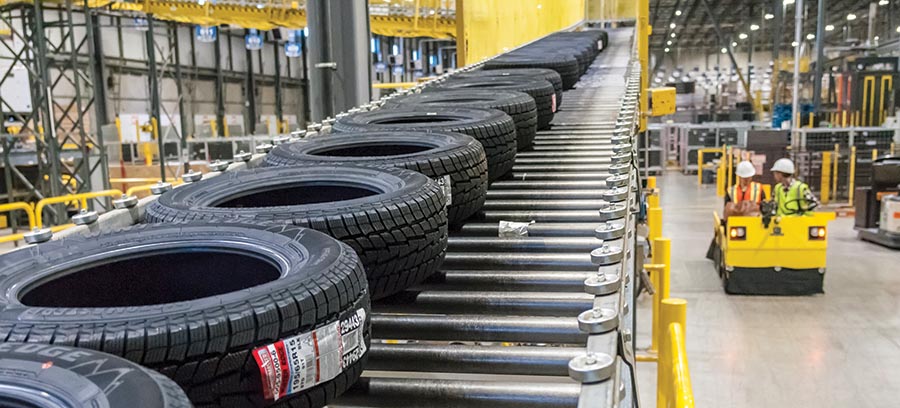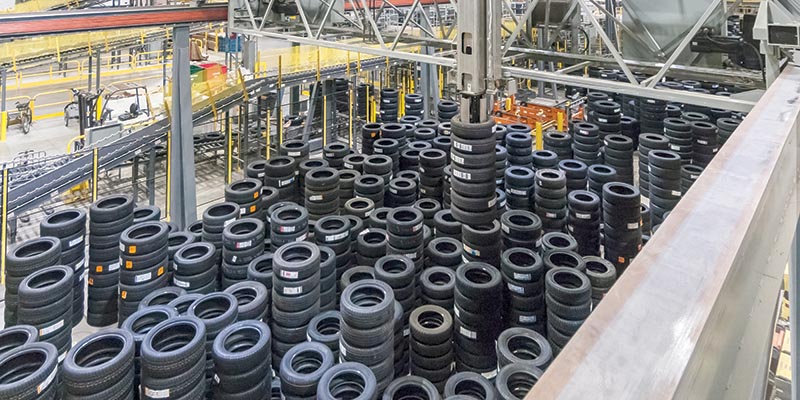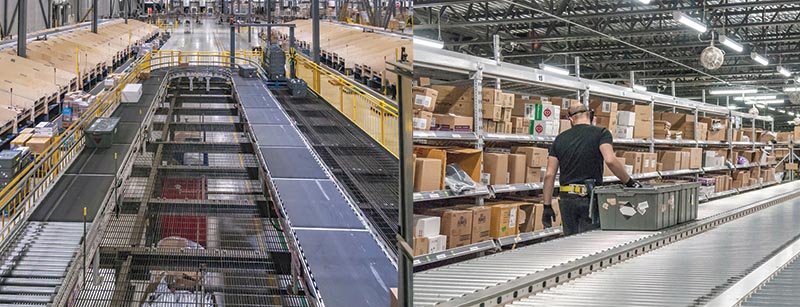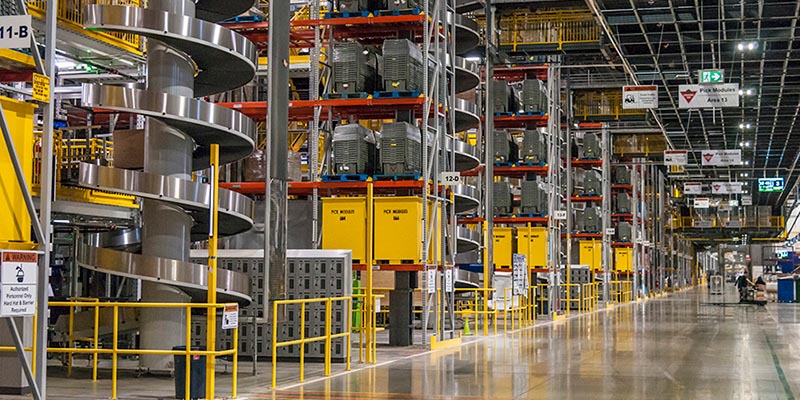In a nearly 1.5-million-square-foot space in Caledon, Ontario—a space equivalent to a good-sized factory—a fleet of 43 automatic guided vehicles (AGVs) shuttles pallets between work areas or puts them away into very narrow aisle storage. In one part of the building, a 250,000-square-foot area is designated to an overhead tire-handling gantry and storage area where two robots move some 20,000 tires a day to fill orders or stock reserve storage. Tuggers deliver pallets that aren’t handled by AGVs to the shipping area.
Click here to take an inside look at the layout of the new Canadian Tire distribution center.
It’s the kind of equipment and activity you would expect in a highly automated manufacturing facility, especially the AGVs and gantry robot. But, Canadian Tire’s Bolton Distribution Centre was designed with a system integrator (Fortna) to handle the retail distribution of larger conveyable and bulk goods, such as lawnmowers and canoes, as well as non-conveyable items like those tires, to some 500 Canadian Tire stores across Canada.
“This was the first time that we know of that the tire gantry robotic system has been used in a distribution center, which meant a great deal of work from a software development perspective,” says Karen Adie-Henderson, associate vice president of the Bolton DC, Canadian Tire Retail. She adds that the AGV fleet represents the most vehicles, especially the very narrow aisle (VNA) AGVs, that the supplier had implemented in one facility, resulting in additional software code.

Newly received tires are conveyed to the gantry robotic tire handling system.
“When we were looking at technology options, we realized that some potential applications of technology typically applied more to manufacturing environments,” adds Geoff Woodcroft, the associate vice president responsible for the distribution project, “but we thought there were real opportunities to apply these technologies in retail distribution, especially in regard to larger conveyable and tire-handling applications.”
Opened in July 2017, the Gold LEED-certified facility consists of three 500,000-square-foot distribution centers under one roof. Building A was designed to automatically handle about 5,000 items that can be conveyed to a unit sorter in their original packaging or in a tote. Building B handles the fastest-moving items, as well as some oversized non-conveyables, like swimming pools, trampolines and televisions. Building C includes the tire-handling area as well as long, large or heavy items that require special handling, such as hockey sticks and snow blowers. Hazardous and flammable items are also stored in a special area in Building C. Each area was designed to maximize the efficient handling of the products managed in that location.

Two gantry robots can handle up to 20,000 tires per day.
Along with the AGVs, gantry robot and tuggers, the facility features:
- 244 dock doors divided between inbound and outbound shipments.
- Five four-level pick modules for conveyable products using pallet, case and shelving pick systems.
- Voice-directed picking and processing.
- 3 miles of hanging platform conveyor, including 40-inch wide conveyor to transport larger traditionally non- conveyable products.
- A cross-belt order consolidation conveyor feeding 197 chutes—half the chutes are designed to handle products weighing 15 pounds or less while the other half are outfitted with motor-driven roller conveyor to control the descent of heavier items. This is the first chute design of its kind.
- RFID scanners in packing to scan items to a pallet or a cart.
- Hydrogen fuel cell lift trucks will be made operational at a later date.
- Fast and opportunity charging for battery-operated vehicles, including the AGVs.
The DC handles 350 trailers a day (175 in and 175 out) and 65 million cubic feet of shipments per year in a seven-day, two shift operation. After 18 months of operation, Canadian Tire is realizing improved product flow, higher fill rates and reduced handling costs. “As we continue to improve our processes, we see the KPIs get stronger and greener,” says Adie-Henderson.

Items are picked to totes in pick modules (right) and then conveyed to a cross-belt sortation system for order consolidation (left).
New location
With revenue of nearly $13.5 billion CAD in 2017, more than 10 banners and 1,700 retail and gas outlets, Canadian Tire Corp. Limited is one of Canada’s largest and best-known retailers. Canadian Tire Retail supports 500 entrepreneurial dealers across Canada and generated more than $7 billion in revenue in 2017 across its five core areas: Automotive, Living, Fixing, Playing and Seasonal. The company likes to say it provides the products for the jobs and joys of life in Canada.
The distribution network to support all of the brands includes seven facilities in Western Canada, six in Central Canada and three in the Eastern part of the country representing regional distribution centers, transload facilities and parts-distribution facilities.
Four of those distribution centers support the Canadian Tire brand. Facilities in Western Canada and Montreal are dedicated to regional distribution of the fastest-moving SKUs. The Bolton facility ships bulk SKUs across Canada. The fourth facility handles regional products.
Planning for the new facility got underway in 2012. At the time, bulk products were being distributed from a nearly 40-year-old facility in Brampton, Ontario. At one time, it was state-of-the-art, with a tow line to move pallets. “It had served us well for many years, but it was at the end of its useful life,” says Woodcroft.
Growth (along with changing order profiles, such as more mixed cartons and mixed pallets and smaller and more frequent deliveries) called for not just more capacity and better flow, but flexible solutions that can accommodate whatever comes down the pike in the future. Fixed, hardwired and expensive to maintain, the tow line was a major impediment to upgrading the existing facility.
In 2012, after a site for the new facility was selected, planning got underway.

Five four-level pick modules are dedicated to conveyable items.
Designing for flexibility
The design of the new facility was driven by several factors. Top of mind was sustainability. “From the very beginning of the design process, our real estate team was committed to making this a LEED-certified building,” says Adie-Henderson (see box, p. 26). It has since been awarded the Gold standard for LEED.
From an operational standpoint, flexibility and scalability for the future were key drivers. That created its own challenges. “One of the difficult things is that you’re doing the upfront planning years in advance of a facility going live,” says Woodcroft. “What’s more, you want to be able to have the flexibility and scalability to change or update the facility once it’s opened based on external business requirements.”
One example of the design for flexibility concept was the choice of fork and VNA automatic guided vehicles for pallet movement. “The towlines were fixed, but AGVs allow us the flexibility to change routes or relocate the AGVs in other parts of the building as required,” notes Adie-Henderson. It’s also easy to expand the fleet in the future. Since going live, Canadian Tire is already looking to expand the use of AGVs to other areas of the facility, including the movement of some hazardous materials.
A third important factor was a system to handle some 20,000 tires a day, ranging from fast-moving items that are stocked in the stores to a custom order for a replacement tire for a 1979 Chevy. This was driven, in part, by the well-being of associates. Canadian Tire’s culture is to leverage its associates for process improvements. “When we talked to the team at the Brampton DC, tire handling was the area they suggested we automate since handling tires is one of the most physical and difficult products to handle in the building,” says Woodcroft. “A newly automated system could help improve productivity in the business while also meeting the needs of the team.”
They chose a tire gantry system commonly used in tire manufacturing after investigating alternatives such as a simple robotic arm and tire depalletizers. The solution begins in the trailer in the receiving area, where tire receiver works from an adjustable platform on the end of an extendable conveyor. The platform can be set at an ergonomic height, eliminating overhead reaching.
Following a scan by a fixed camera-imaging system, the tires are directed to one of two lanes where they are handled by two robots. When an immediate demand for a SKU is made, it’s moved to a location for picking. Otherwise, tires are palletized and put away in a stock location in the very narrow aisle reserve storage area by a VNA AGV. The AGV can interleave tasks, retrieving a pallet needed for replenishment after a putaway move.
“When the system is at its best, it’s doing inbound putaway, replenishment and order picking for outbound all at the same time,” says Adie-Henderson. Orders are picked by the robot to a cart; when four carts are full, a tugger operator delivers them to the shipping area.
More innovations were implemented in the conveyable/totable warehouse, which features five four-level pick modules. Here, associates are directed by voice to pick conveyable items—or items like cans of paint that can be conveyed in a tote—weighing up to 50 pounds to conveyor. Items go to a cross-belt consolidation sorter with two types of chutes: One handles items that weigh 15 pounds or less and another is outfitted with motor-driven roller conveyor to control the descent of heavier products weighing up to 50 pounds.
Items are put in totes and palletized for shipment in the pack station using product segregation rules to prevent putting food with aerosols or other products. Once orders are palletized, the pallet is moved by AGV to the outbound consolidation where they will be loaded onto a truck for delivery.
While Building A is highly automated, Buildings B and C use conventional materials handling and picking processes directed by voice. Some hard-to-handle products, like water heaters, are handled by clamp trucks.
Building sustainably at Canadian Tire
Creating a Gold LEED-certified facility started with the choice of building materials, including materials with Canadian content, along with a system to track and trace all of the material used by Canadian Tire and its vendors.
Some of the design features are common to other LEED facilities. For instance, LED lights are used inside and outside the facility, and lights only come on in work areas like the pick modules when people are present. Large windows let in natural light, further reducing the need for energy use. An automated system controls air flow and circulation.
“Canadian winters are not for the faint of heart,” says Adie-Henderson. “But I can wait to turn on the heaters much later in the season than in the old building.”
In particular, the Bolton DC received Gold LEED certification for the site’s remediation and storm water management efforts, drought-tolerant landscaping and low-flow fixtures reducing water use, and high-performance equipment reducing energy consumption. The roof was designed to enable the addition of solar in the future.
The facility will eventually use hydrogen-powered lift trucks with the hydrogen generated onsite. Canadian Tire was the first retailer to generate its own hydrogen onsite at the Brampton DC.
The design also took employee well-being into account. The facility includes a well-appointed cafeteria, a Tim Hortons coffee shop, a bicycle storage area and a shower. Finally, the new facility is delivering logistics benefits that reduce the carbon footprint. It is located nearer the intermodal yards, reducing the distance traveled to get product from the rail yards to the DC.
Moreover, car pooling is encouraged, and there are electric car charging stations in the front of the building. “A year ago, there was one car,” says Adie-Henderson. “Now, there are eight cars parked there on a consistent basis. Employee behavior is changing.”
Continuous improvement
The Bolton facility went live in July 2017. Given the time between design, build and go-live, requirements often change before the start-up, and this one was no exception. For instance, Adie-Henderson notes, the company’s tire business has grown by 25% in 2018. The design, however, has proved to be flexible and scalable—one of those key design criteria. “We’ve been able to handle the increased volume and at a reduced cost,” Adie-Henderson says. In fact, within 13 weeks of going live, the facility was receiving and shipping 1 million cubic feet of shipments per week.
Continuous improvement has also been important to building on those early successes. Working with its system integrator, Canadian Tire employees contributed more than 400 ideas to improve processes, and so far more than 130 have been implemented. “That mindset is such a part of the Canadian Tire fabric and how we support our business partners,” Adie-Henderson says.
Improved receiving processes have resulted in reduced inbound unloading times and the ability to turn dock doors faster than at the old facility. And, as noted earlier, KPIs that matter most have improved on a regular basis. “In one year here at Bolton, the gains in safety and productivity are outpacing what we did at Brampton over all that time,” says Woodcroft. “The best is yet to come.”
Article topics








